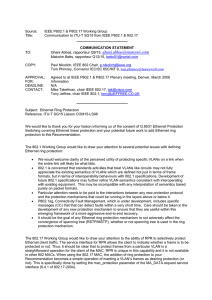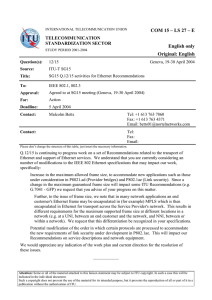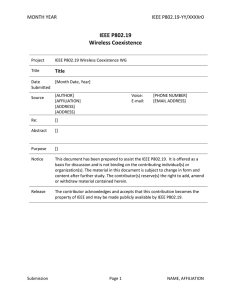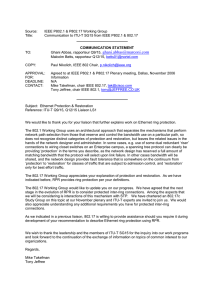Source: IEEE P802.1 & P802.17 Working Group Title:
advertisement
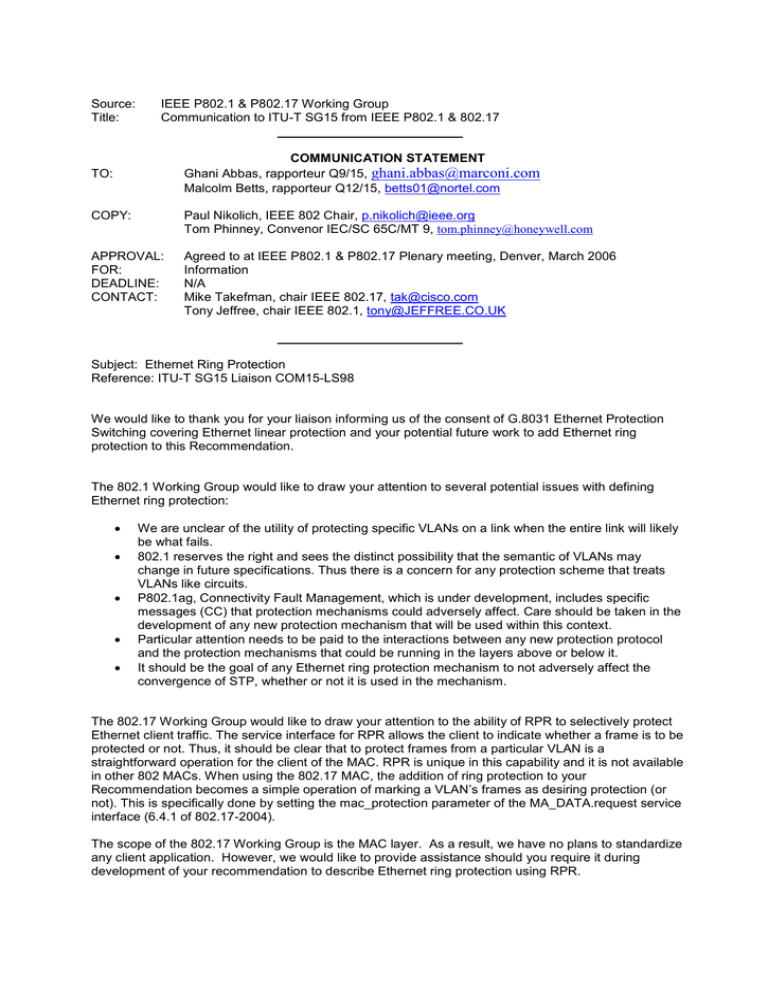
Source: Title: IEEE P802.1 & P802.17 Working Group Communication to ITU-T SG15 from IEEE P802.1 & 802.17 COMMUNICATION STATEMENT Ghani Abbas, rapporteur Q9/15, ghani.abbas@marconi.com Malcolm Betts, rapporteur Q12/15, betts01@nortel.com TO: COPY: Paul Nikolich, IEEE 802 Chair, p.nikolich@ieee.org Tom Phinney, Convenor IEC/SC 65C/MT 9, tom.phinney@honeywell.com APPROVAL: FOR: DEADLINE: CONTACT: Agreed to at IEEE P802.1 & P802.17 Plenary meeting, Denver, March 2006 Information N/A Mike Takefman, chair IEEE 802.17, tak@cisco.com Tony Jeffree, chair IEEE 802.1, tony@JEFFREE.CO.UK Subject: Ethernet Ring Protection Reference: ITU-T SG15 Liaison COM15-LS98 We would like to thank you for your liaison informing us of the consent of G.8031 Ethernet Protection Switching covering Ethernet linear protection and your potential future work to add Ethernet ring protection to this Recommendation. The 802.1 Working Group would like to draw your attention to several potential issues with defining Ethernet ring protection: We are unclear of the utility of protecting specific VLANs on a link when the entire link will likely be what fails. 802.1 reserves the right and sees the distinct possibility that the semantic of VLANs may change in future specifications. Thus there is a concern for any protection scheme that treats VLANs like circuits. P802.1ag, Connectivity Fault Management, which is under development, includes specific messages (CC) that protection mechanisms could adversely affect. Care should be taken in the development of any new protection mechanism that will be used within this context. Particular attention needs to be paid to the interactions between any new protection protocol and the protection mechanisms that could be running in the layers above or below it. It should be the goal of any Ethernet ring protection mechanism to not adversely affect the convergence of STP, whether or not it is used in the mechanism. The 802.17 Working Group would like to draw your attention to the ability of RPR to selectively protect Ethernet client traffic. The service interface for RPR allows the client to indicate whether a frame is to be protected or not. Thus, it should be clear that to protect frames from a particular VLAN is a straightforward operation for the client of the MAC. RPR is unique in this capability and it is not available in other 802 MACs. When using the 802.17 MAC, the addition of ring protection to your Recommendation becomes a simple operation of marking a VLAN’s frames as desiring protection (or not). This is specifically done by setting the mac_protection parameter of the MA_DATA.request service interface (6.4.1 of 802.17-2004). The scope of the 802.17 Working Group is the MAC layer. As a result, we have no plans to standardize any client application. However, we would like to provide assistance should you require it during development of your recommendation to describe Ethernet ring protection using RPR. We wish to thank the leadership and the members of ITU-T SG15 for the inquiry into our work programs and look forward to the continuation of the exchange of information on topics of common interest to our organizations. Regards, Mike Takefman Tony Jeffree
